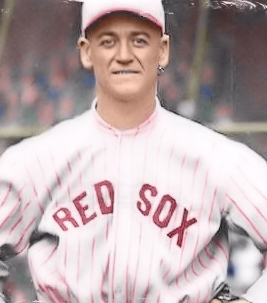|
“FENWAY'S BEST PLAYERS”  |
|||
George Henry Burns was born on January 31, 1893 in Niles, Ohio, but lived in Tioga, Pennsylvania, and then later in Philadelphia. George attended Philadelphia Central High School, but dropped out at age 16 to pursue a career in baseball. He signed his first professional contract in 1913 for $150 a month with Quincy (IL) of the Central Association. He was dealt to Burlington (IA), and also played for Ottumwa (IA), all members of the same league. Burns continued his tour of the Hawkeye State, suiting up for Class A Sioux City (IA) of the Western League. He hit .301 for the Packers, and hit 12 home runs. His contract was purchased by the Detroit Tigers. He was inserted into manager Hughie Jennings’ lineup as the everyday first baseman. Burns showed he belonged, hitting .291 his rookie year on a team that included Ty Cobb, Sam Crawford, and a young Harry Heilmann. Cobb took Burns under his wing, giving him pointers on hitting. However, Burns led the league in errors with 30. It was the first of four seasons he led the league in this dubious distinction. It was not a secret to many that Burns and Jennings had a rocky relationship. In 1917, it deteriorated more as Burns suffered through his worst offensive season, hitting .226. He endured prolonged batting slumps, which he attributed to an ailing knee. Connie Mack was looking to shake up his last-place club, and dealt productive first baseman John “Stuffy” McInnis to the Red Sox for their players. He was looking for a first baseman, and learned that Burns could be had from the Tigers. Mack had an outfielder, Ping Bodie, who he could deal. The Yankees purchased Burns for $6,000 and sent him to the A’s for Ping Bodie. Mack looked like a genius when Burns led the league in hits with 178. He was also second in RBIs (70) and second in batting average (.352). Although he hit .296 in 1919, Burns found out that Philly fans could be very fickled and boisterous, whether you were a hometown product or not. He suffered through a slow start at the plate, posting a .255 average for May and June. The hecklers rode him, and his defense suffered. On May 29, 1920, Burns was sold to Cleveland for $10,000. He was used primarily as a backup to Doc Johnston, and a right-handed bat off of Speaker’s bench. Although Burns hit a robust .361 in 1921, he was still a backup to Johnston at first base. Speaker coveted Boston’s Stuffy McInnis, a slick fielder but mostly a singles hitter, as his first sacker. On December 24, 1921, Cleveland dealt Burns, outfielder Joe Harris, and Elmer Smith to Boston for McInnis. It was with the Red Sox where Burns career solidified, now that he was in the lineup every day. He hit over .300 in both 1922 and 1923, and reached his career high in home runs (12) in 1922. Despite leading the league in errors both years, Burns was a key contributor to Boston’s offensive attack. Burns earned two distinctions in 1923. He became the first player to get a hit in Yankee Stadium on April 18th, off of New York’s Bob Shawkey in the second inning. Unfortunately, for George, he was thrown out trying to steal second base. His other feat occurred on September 14th, when he completed an unassisted triple play against his old mates from Cleveland. In the top of the second inning, Tribe second baseman Riggs Stephenson led off with a single to left field and third baseman Rube Lutzke followed with a walk. Up stepped first baseman Frank Brower, and Speaker put the hit-and-run play on. Brower smashed a line drive headed to right field But the ball never got there as Burns snared it from his position at first base and tagged Lutzke for the second out. Seeing that Stephenson was retracing his steps to second, Burns raced to the bag, sliding and beating the runner by a whisker. It was the third unassisted “hat trick” in the big leagues, and it has only been accomplished 15 times in major-league history. After the 1922 season, Speaker realized that the Burns-McInnis swap two years earlier had not worked to his advantage. Speaker was a man who admitted when he made a mistake, and reacquired Burns from Boston on January 7, 1924. Burns initially held up the deal, believing that he deserved a bump in salary since he was the principal part of the deal. With the particulars worked out, Burns was once again an Indian. Over the next four years, Burns was a mainstay at first base for the Tribe. He later became a player-manager for various teams in the Pacific Coast League, including the Mission Reds, the Seattle Indians and the Portland Beavers. His playing days long behind him, Burns settled in the Seattle area, taking a job as a sheriff’s deputy in King County in 1947. George was employed by the sheriff’s department until he retired in 1968. He passed away after an eight-year battle with cancer on January 7, 1978, in Kirkland, Washington.
|
|||

